Red wings aren’t necessarily typical on bugs. Many species have brown or black wings to better blend in with the environment.
Other species are known to have red wings. This helps them stay away from potential predators as red acts similarly to a warning sign.
Pure vivid red wings are rare in the world of bugs and insects. Many species with red wings have a darker shade of red, with rust, orange, or brown undertones.
Others may also have a lighter red nuance, closer to pink.
Aposematism refers to certain cues a species give off to appear toxic. While they may or may not be toxic to predators, the specific stand-out trait can be the vivid color of the wings, such as red.
The aposematic red coloring is specific to a few adult bugs and caterpillar bugs.
You can notice the color of the species changing into adulthood as some caterpillars may have a different color than the final coloring of the adult.
Moths, beetles, bugs, and insects often have red wings. These colorful wings may suit them in mating or to keep all types of predators such as wasps away.
Some bugs with red wings are predators themselves.
Some species of wasps come with red wings and they don’t use them for defensive purposes as they can prey on spiders and tarantulas.
Red wings on the following species are sometimes environment adaptations. They might help a certain bug find a mate sooner or they might help bugs appear dangerous to other species.
Table of Contents
1. Spotted Lanternfly

Spotted Lanternflies (Lycorma delicatula) are an introduced pest species in the United States. This type of planthopper comes from China, South Korea, and Japan.
It has red hindwings which are only seen when it flies. Otherwise, its pink forewings have small black dots.
Some Spotted Lanterflies have gray forewings.
While there are many types of hosts, the Spotted Lanternfly is mostly tied to varnish trees or trees of heaven.
This species is a known pest of many ornamental plants and trees in the United States.
Among them, are the Chinese cedar, amur cork trees, and five-fingers.
Northeastern US territories are highly exposed to damages from the Spotted Lanternfly.
As it overwinters in an egg phase, management techniques involve removing the eggs from the trees as soon as possible.
These eggs can be removed with tools or by hand from October onwards.
A mass of eggs might be covered in a sticky substance right on tree bark. Other eggs are laid on hard surfaces (such as rocks) next to the host tree.
Otherwise, these eggs start to develop into nymphs. Early stage Spotted Lanternfly nymphs are only black.
They start to become mostly red as they mature.
Trees infested by the caterpillar or the adult Spotted Lanternfly give off certain cues.
Since they feed on leaves and bark sap, the infested tree starts to excrete a type of thick sap.
These secretions can also attract other types of invasive species such as aphids which means infested trees can suffer more.
2. Red Net-winged Beetle
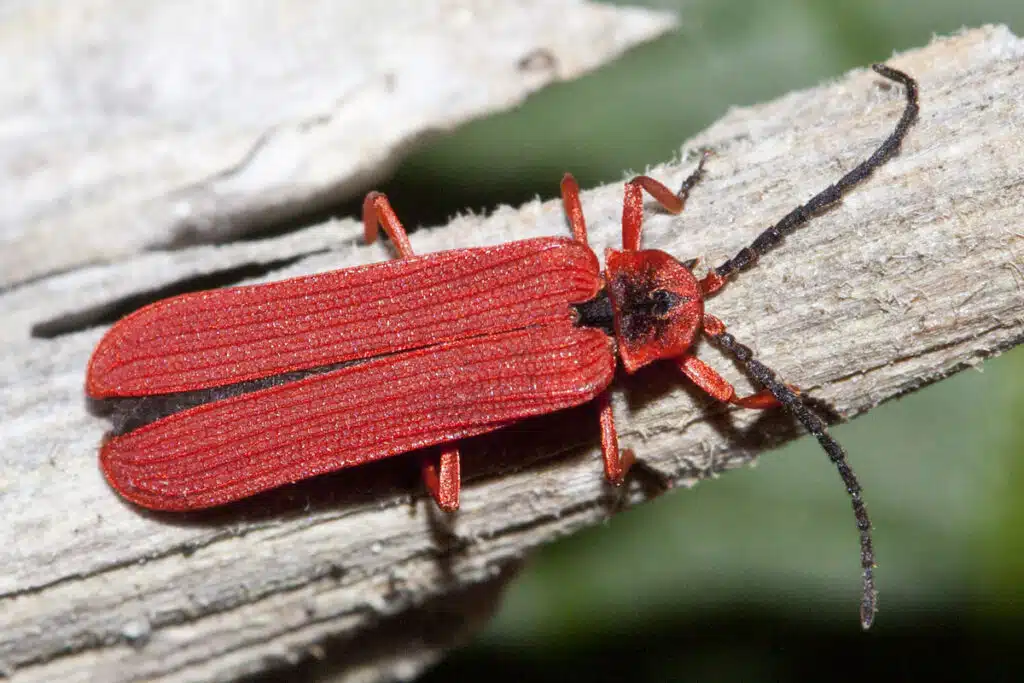
Red Net-winged Beetles (Dictyoptera simplicipes) are a species with red forewings and smoky black hindwings.
The species’ forewings have a rusty-red color with visible lines or grooves.
Beetles of this family have a black body and black hindwings which are covered by resting forewings.
A North American native, the Red Net-winged Beetles have red legs while the antennae are mostly black.
Rare Red Net-winged Beetle species have orange forewings instead of red forewings.
3. Blood-winged Blister Beetle
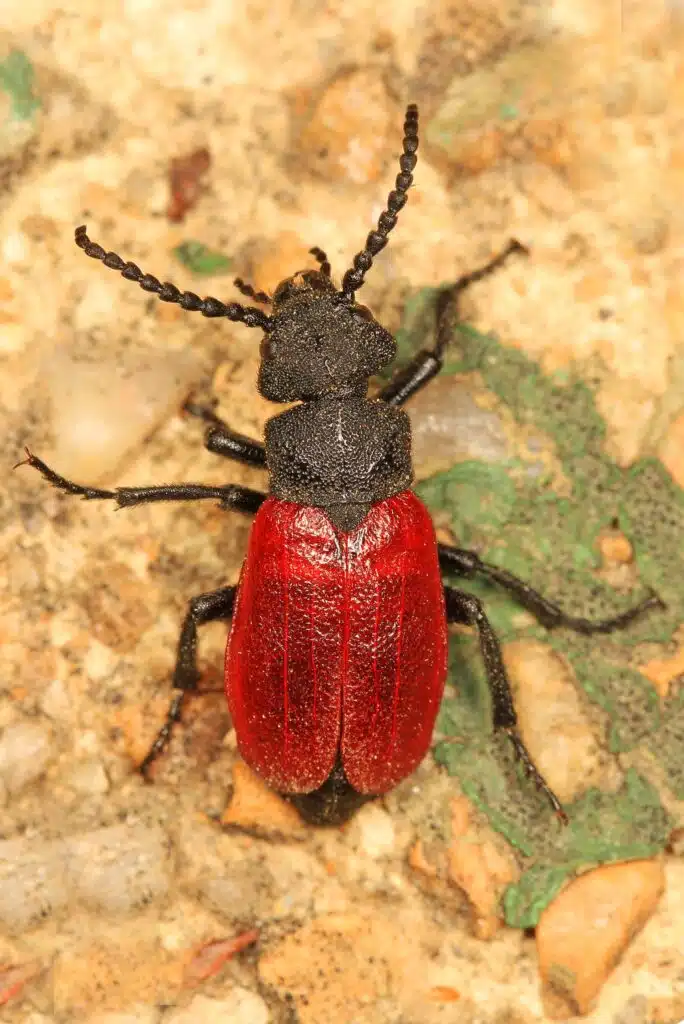
The Blood-winged Blister Beetle (Tricrania sanguinipennis) gets its name from its dark red body.
The red nuance of the beetle has brown or rust undertones while the rest of its body is black.
Both the head and its legs are black.
Northeastern US territories are among the habitats where the species is found in.
Its range expands down to Florida, albeit with Southern populations being present in lesser numbers.
Blood-winged Blister Beetles cannot fly but they exhibit parasitoid traits as they live off different bee species.
These beetles nest in the ground or underground bee nests.
4. Bloody Net-winged Beetle
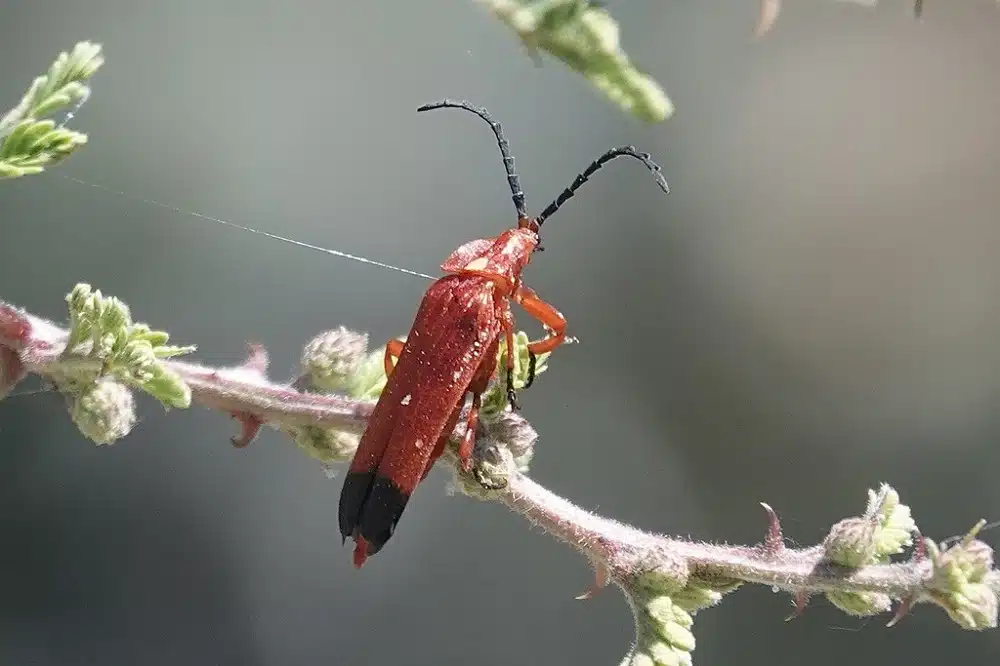
These beetles (Lycus sanguineus) are known for feeding on nectar. The North American natives have mostly red wings.
The body and the wings of the Bloody Net-winged Beetle are red. Only the tips of its wings are black,
Bloody Net-winged Beetles have long black antennae.
Their legs show a combination of black and red coloring as well.
Growing to an average size of 15mm, these beetles have similar coloring between the sexes.
Females have a small physical size difference as they’re larger than adults.
You can see Bloody Net-winged Beetles on various flowers as they feed on nectar through the summer months.
5. Golden Net-winged Beetle
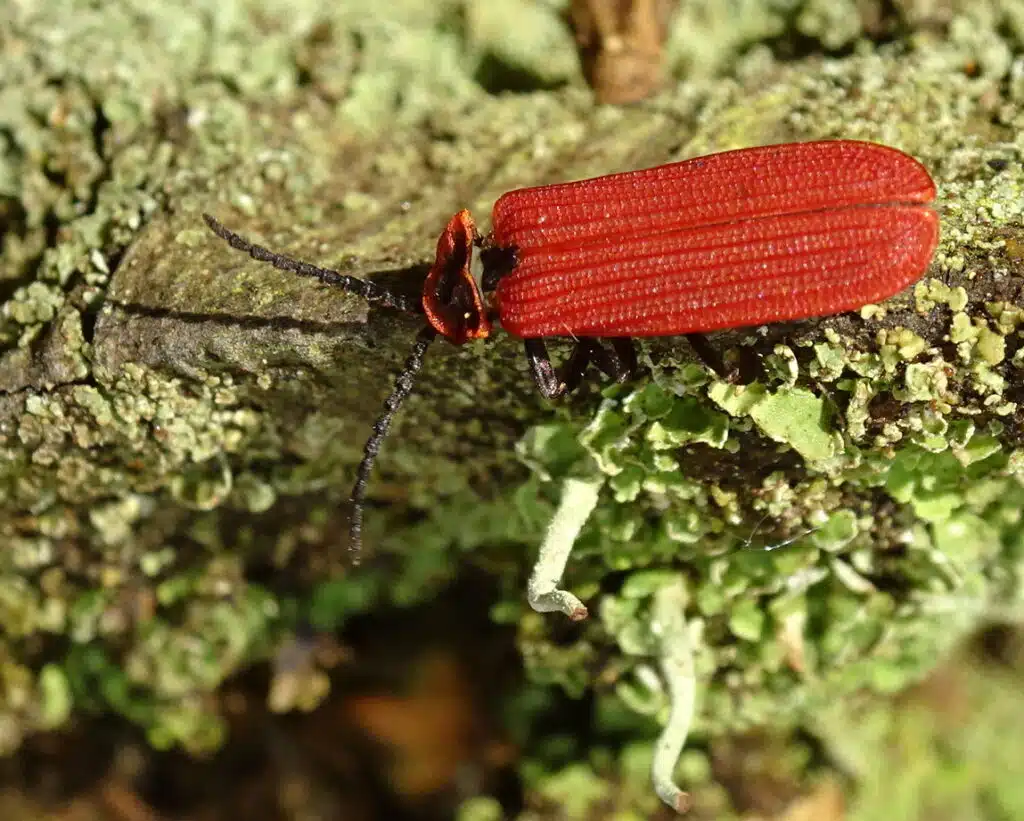
Golden Net-Winged Beetles (Dictyoptera aurora) are among the most common species across Europe and North America when it comes to woodlands habitats.
These beetles live in an expansive territory across coniferous woodlands at high elevations.
Their wings are completely red with ridges.
Its pronotum is also red with central black marks. The legs and antennae of the species are mostly black.
Growing to a maximum size of 15mm, this species has vivid coloring to turn potential predators away.
You can find Golden Net-winged Beetles feeding on the nectar of various flowers. These beetles may also consume larvae of other species.
The larvae of Golden Net-winged Beetles eat moist-affected or rotting wood.
While its larvae feed on rotting wood, it poses no harm to humans as it doesn’t bite or sting.
Humans are also safe handling Golden New-winged Beetles which don’t bite.
6. Tarantula-hawk Wasp
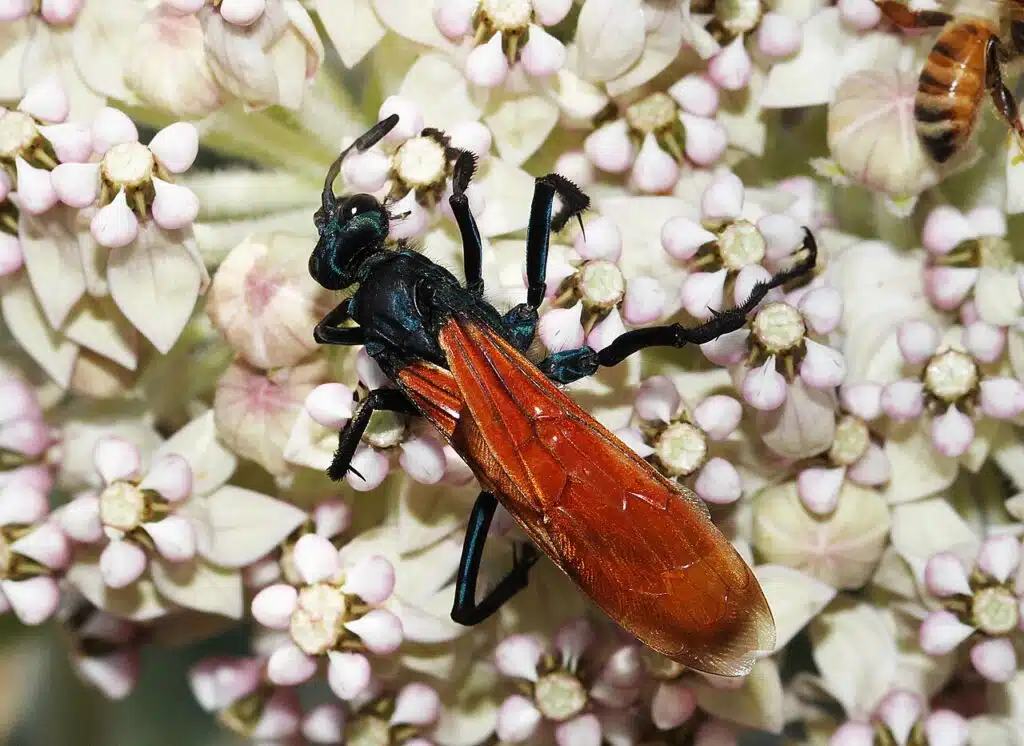
This species (Pepsis thisbe) has yellow, orange, or orange-red wings. It’s one of the most feared wasps in North America due to its painful sting.
These wasps are known for paralyzing or killing tarantulas on which they lay an egg on. The wasp egg hatches and the emerging larvae start to feed on the tarantula.
Only female wasps of this genus sting, while males don’t have stingers.
Thisbe’s Tarantula Hawks grow to a size of up to 2 inches and are common in areas with tarantulas, such as The Grand Canyon.
It’s here that the wasps sting tarantulas and drag them on the ground back to their nests.
Female wasps have a very painful sting which requires medical attention in humans. However, these wasps don’t sting frequently unless provoked.
The species has few natural predators due to its potentially deadly sting on smaller animals and insects.
7. Eastern Tawny-horned Spider Wasp
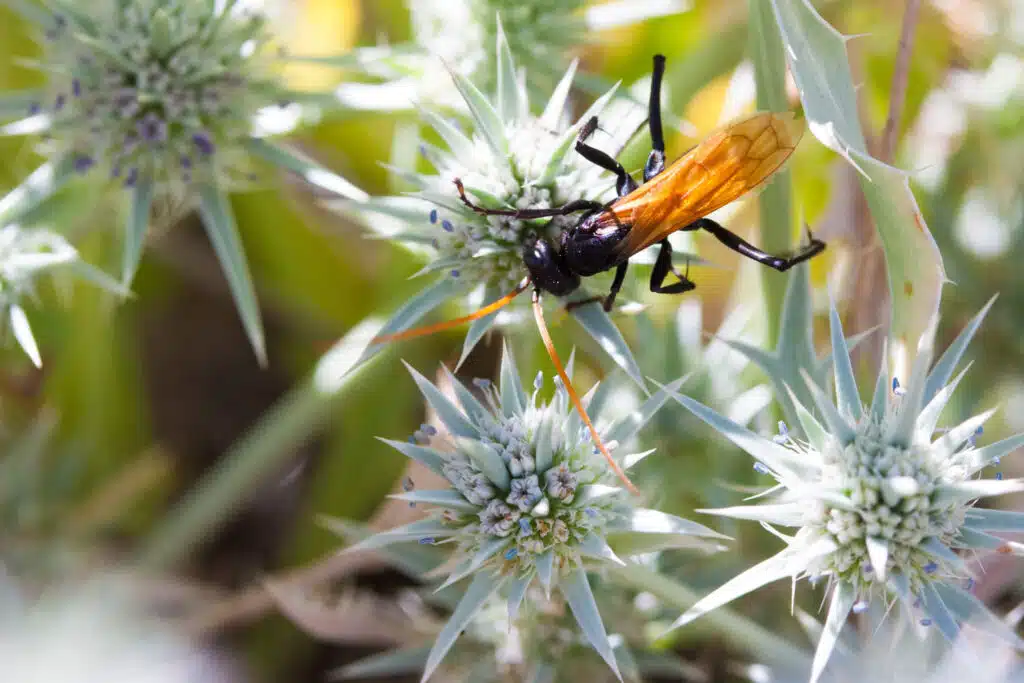
This type of wasp (Entypus unifasciatus) is also known for its colorful orange or red wings. It lives all over North America but not in the Northwestern regions of the continent.
Like other tarantula hawk wasps, it kills tarantulas but also other spiders more common in other regions in the country.
Large species of wolf spiders are among its common prey.
This species can paralyze a spider a few times larger than the wasp itself. They drag it back to the nest where it serves as food for the laid egg on the abdomen of the spider.
Growing to a size of 30-40mm, the Eastern Tawny-horned Spider Wasp is among the most common species with a painful sting.
People should avoid direct contact as the sting of the species is among the most painful in the world of sects.
Eastern Tawny-horned Spider Wasps emerge in the summer.
8. Milde’s Tarantula-hawk Wasp
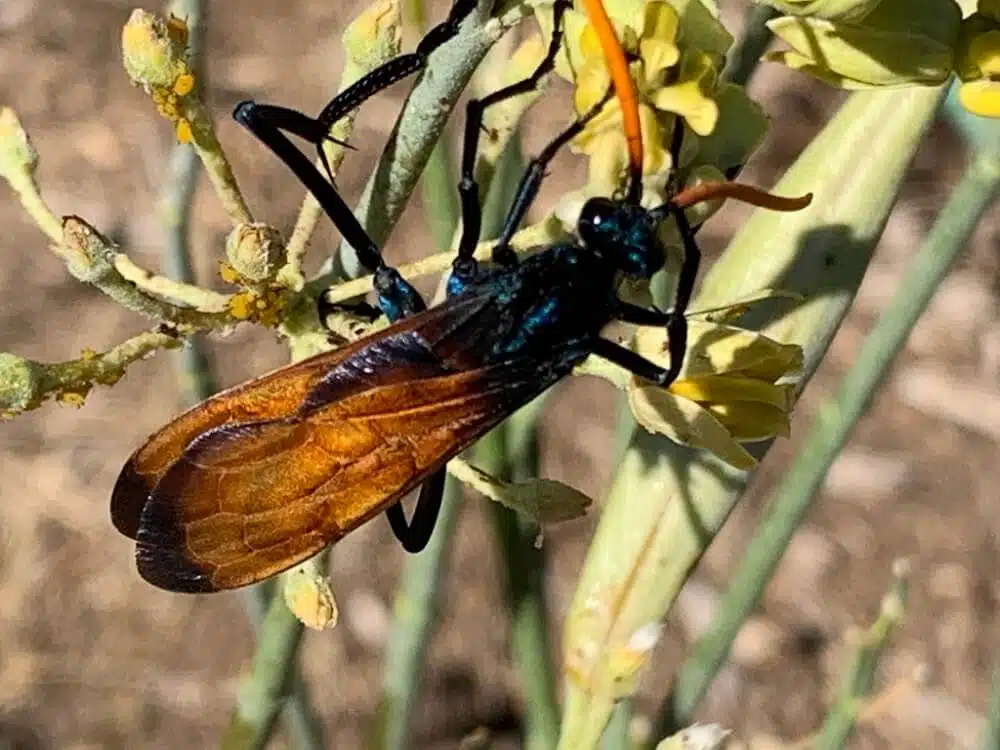
This species of tarantula-hawk wasps (Pepsis mildei) may come in red wings and red antennae while its body is almost black.
A potent sting is attributed to the wasps which may paralyze tarantulas for life.
The paralyzed tarantula is hunted by the wasps. It may find tarantulas out in the open or seek them out in its nests.
Female Milde’s Tarantula-hawk Wasps typically succeed in stinging tarantulas, even in their nests.
The living paralyzed tarantula is dragged back to a nest where a wasp egg is laid on it.
The emerging larvae feed on the paralyzed tarantula.
While this species has a painful sting, it’s not considered deadly to humans
9. Elegant Grass-Carrying Wasp
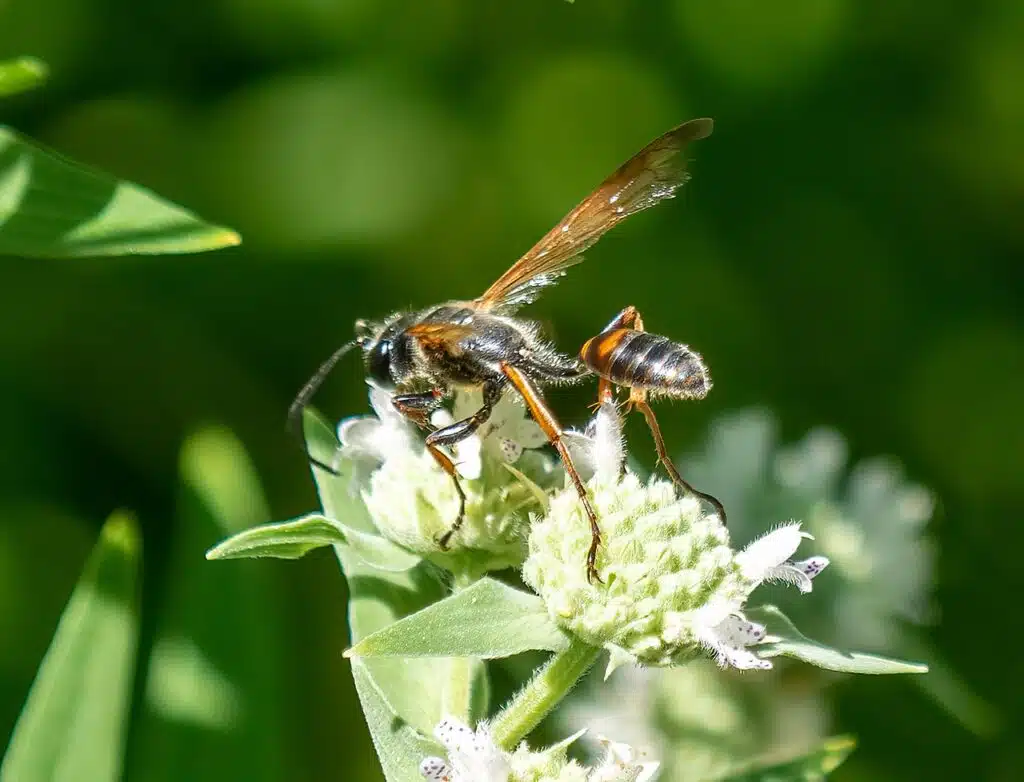
Red, red-brown, or black wings are specific to the Elegant Grass-Carrying Wasp (Isodontia exonata).
This is a species known for its capacity to feed bugs to its emerging offspring.
Unlike tarantula hawk wasps, grass-carrying wasps nest above the ground. They use dry grass to create a small shelter or a small nest where the bug and the egg are brought.
Wasps of this family don’t look for tarantulas but for crickets.
They find crickets by smell, similar to tarantula hawk wasps.
Once located, the cricket is stung by the females stinger and paralyzed. It’s then transported to an above-ground nest and an egg is laid on top.
The species is part of the thread-waist wasps which means it can also be identified by its thin thread-like waist.
10. Virgin Tiger Moth
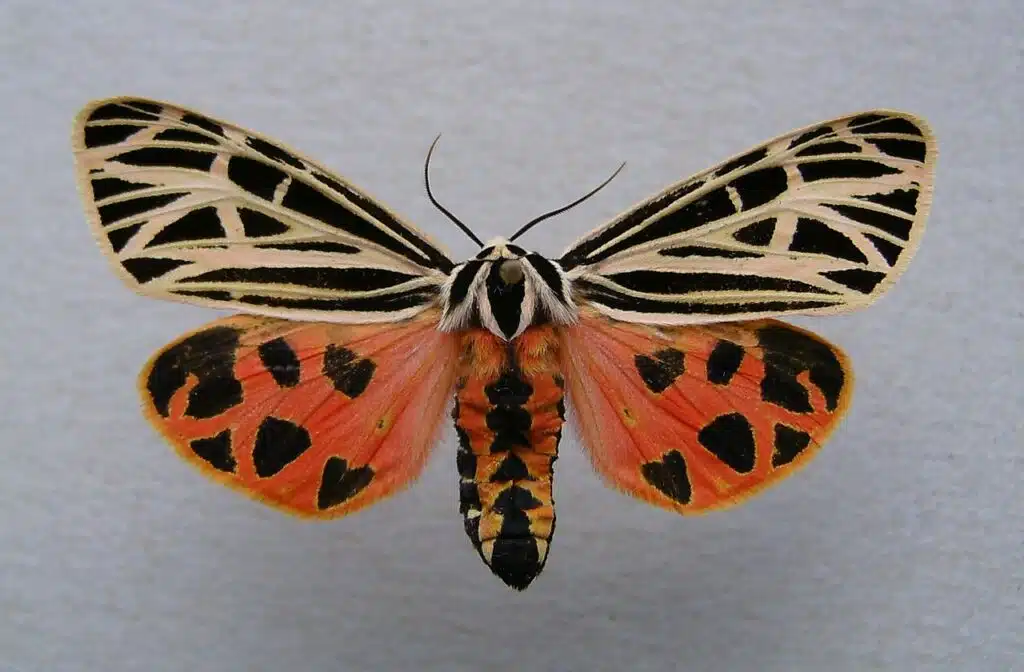
Eastern and Northeastern US territories are home to the Virgin Tiger Moth (Apantesis virgo).
This is a species of moths that can come in a yellow and black color or a red and black color.
Its hindwings are mostly red and are distinctly colored from the white and black forewings.
The lower body of the Virgin Tiger Moth is also red, while its upper body is white and black or cream and black.
Common on prairies, the moth can reach a wingspan of up to 56mm.
It feeds on the pollen of different types of plants and flowers found on prairies, such as thermopsis flowers.
You can see this colorful moth species on different other flowers in open fields. It prefers short flowers as it flies just above the ground.
11. Ultronia Underwing
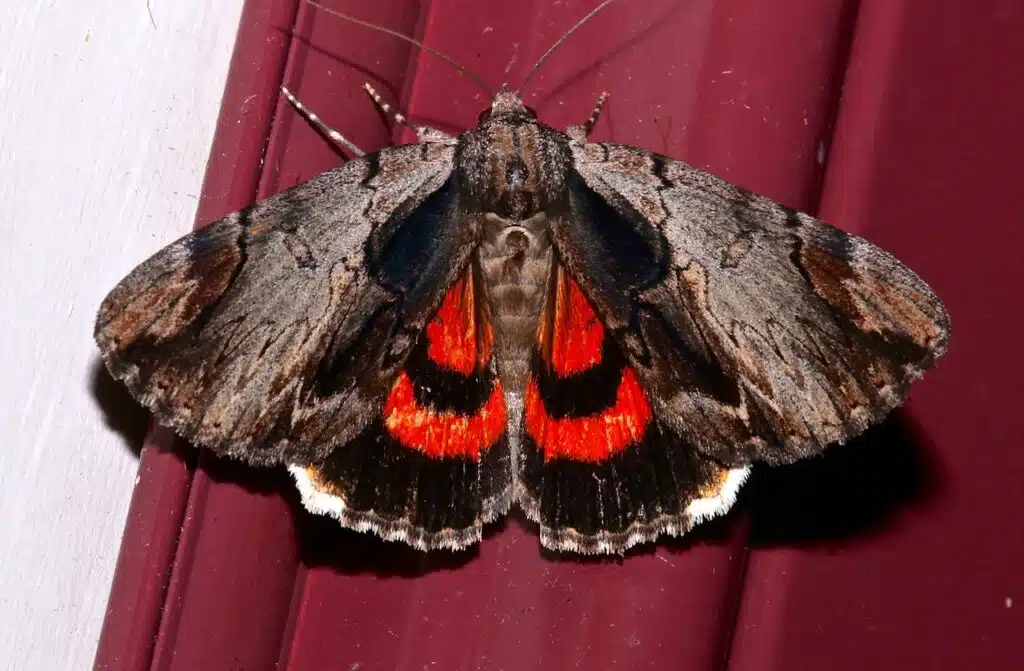
This species of moth (Catocala ultronia) is native to Southeastern US states.
It has brown forewings and red hindwings. The species has black bands across its red underwings.
Ultronia Underwing moths can also come in brown and orange colors instead of brown and red main colors.
This is a large species with an expected maximum wingspan of 60mm. However, it also comes in a shorter wingspan at times, closer to the 50mm mark.
This moth is known for eating different types of tree leaves such as the leaves of aspen in its larvae stage.
It can also be found on poisonous trees in North America. These are trees similar to black cherry.
This moth is only seen in one generation per year. A single brood is seen once the overwintering eggs hatch.
Most of the surviving overwintering eggs of the species develop under dry leaves, on the ground.
12. Cinnabar Moth
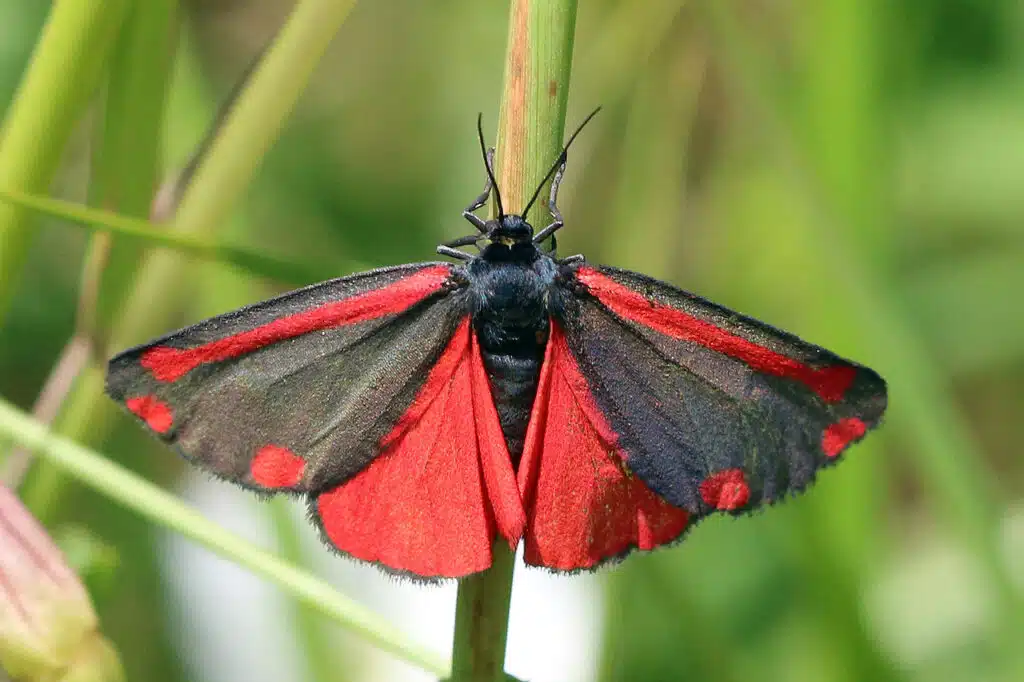
Mostly red wings with black stripes and black margins are seen on some Cinnabar Moths (Tyria jacobaeae).
It has red bands on its black forewings and mostly red hindwings.
This species begins life as an orange and black caterpillar. It only turns red in its pupal stage.
A high multiplication rate is specific to Cinnabar Moths.
Hundreds of eggs can be laid by a single female. The female Cinnabar Moth often chooses ragwort as a host species.
This plant is the food source for the emerging caterpillar.
Cannibalistic traits have also been specific to these caterpillars at times.
The red and black coloring of the adult Cinnabar Moth normally acts in its favor as this species can be perceived as poisonous by predators.
Some exceptions apply, particularly between ants.
Real wood ants are among the common Cinnabar Moth caterpillar predators.
13. Scarlet-winged Lichen Moth
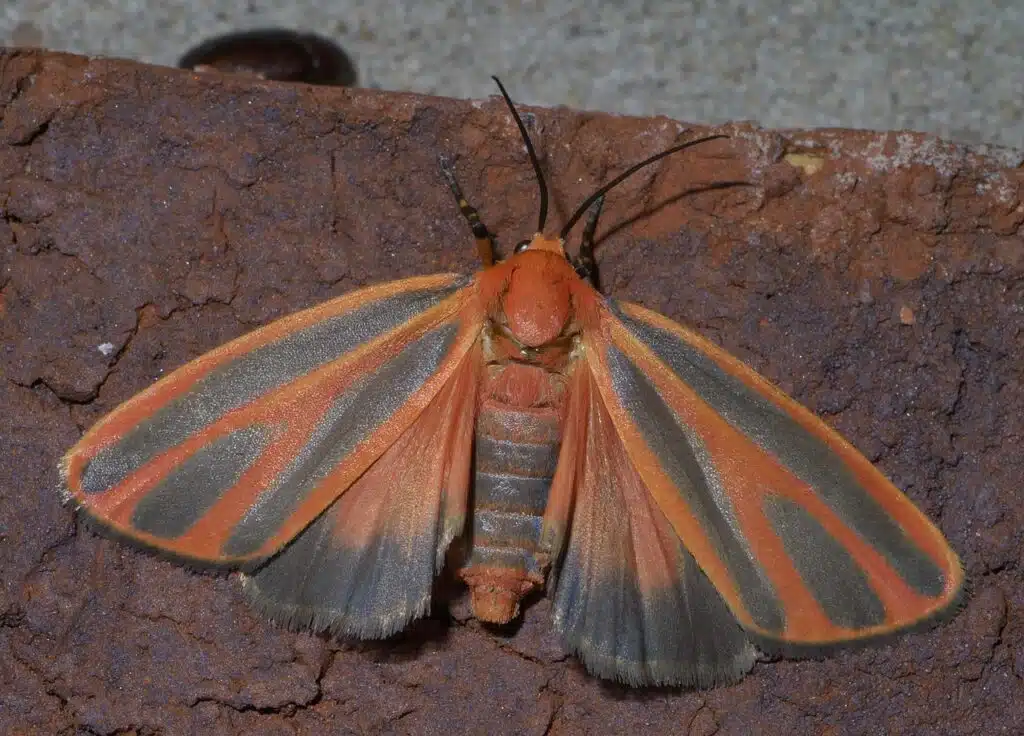
A combination of red and black wings is specific to the Scarlet-winged Lichen Moth (Hypoprepia miniata). This is a species that doesn’t come in different colors.
Red and black stripes are seen across its forewings.
The moth grows to a moderate size with a maximum wingspan of 17mm.
Moths of this family are native to the North American continent where they share summertime activity across multiple regions.
However, some regions of North America show Scarlet-winged Lichen Moth activity from spring to summer while it gets to be active until early fall in other regions.
The species is seen in early spring in the East.
As its name suggests, the moth species is mostly tied to lichen, an organic source of food.
Lichen on various trees such as pine trees is ideal hosts for the Scarlet-winged Lichen Moth.
14. Spotted Oleander Moth
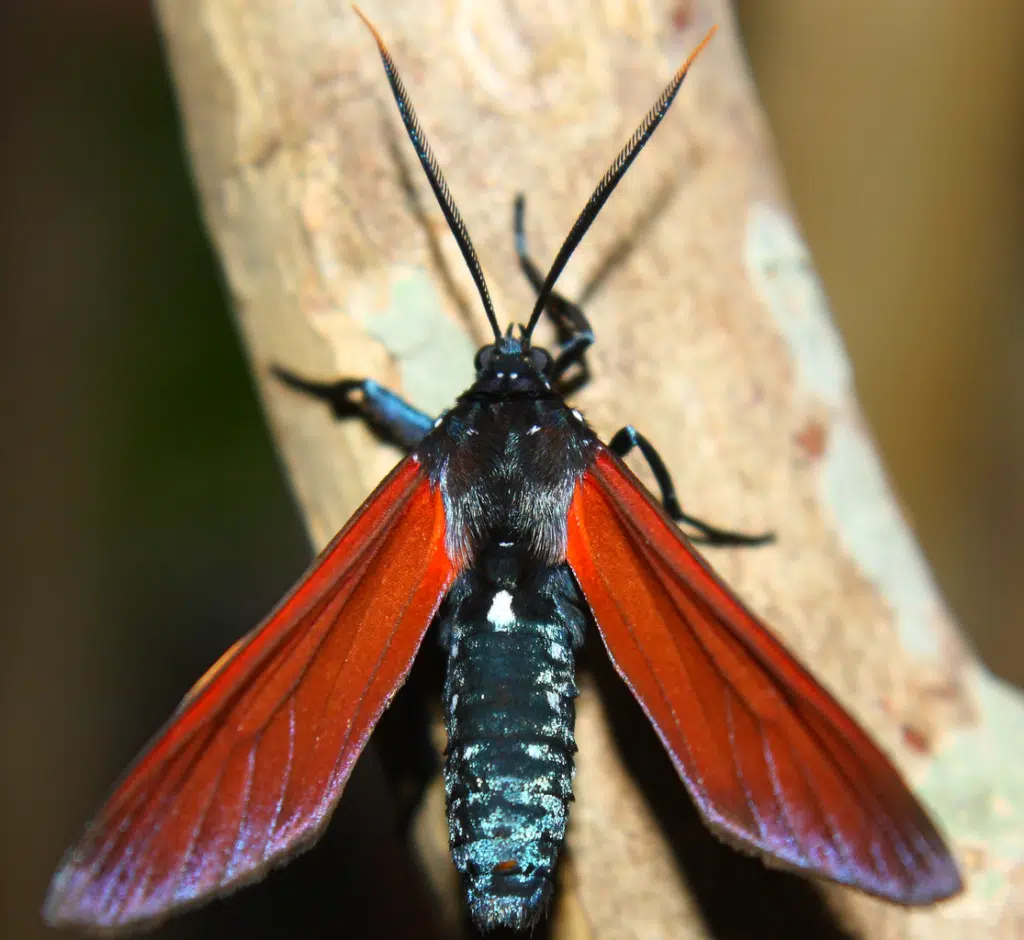
This spotted moth species (Empyreuma pugione) has a black body and red wings.
It has a North American presence and a wide Central American distribution.
Spotted Oleander Moths begin life as orange caterpillars. They slowly darker to a red to brown color which represents their pupal stage before settling as red and black adults.
The species has vivid black coloring on the forewings with a slight darkening towards the wing tips.
Spotted Oleander Moths are only seen on oleander plants.
Their damage is small to these plants which means they aren’t actual pests.
A reduced damaged specificity is mostly tied to the high number of predators.
Wasps are among the most common reasons Spotted Oleander Moths aren’t a big problem on oleander plants.
15. Joyful Virbia Moth
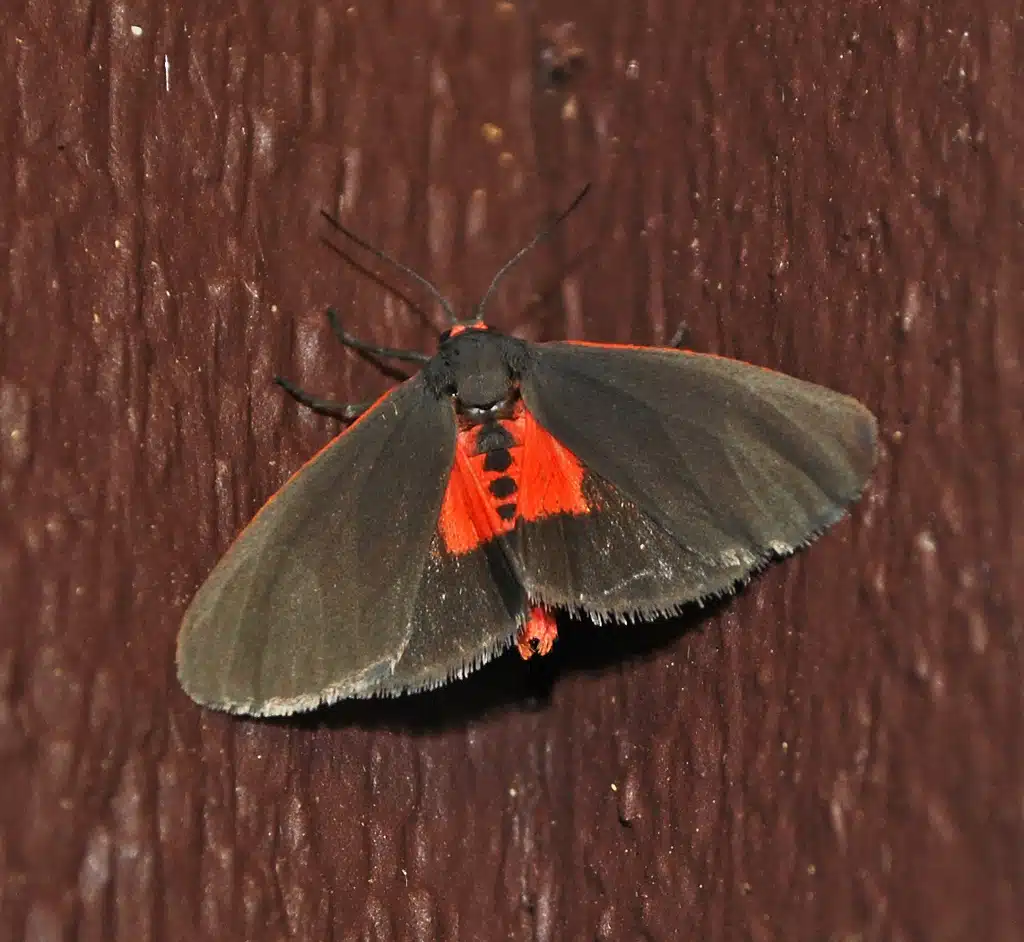
Joyful Virbia Moths (Virbia laeta) are native to North America. They are seen around many states and are known to have red hindwings.
Its forewings are mostly black while the hindwings are either red, pink, or salmon-pink.
This species can be separated into genders by the sizes of each individual. Males grow to a maximum of 11mm size while larger females can reach a maximum wingspan of around 17mm.
Joyful Virbia Moths are seen in a different number of broods depending on their region.
Food availability also dictates the natural habitat of Joyful Virbia Moths.
The species is seen feeding on plants such as dandelions.
Southern states such as Texas are the regions where the Joyful Virbia Moths are seen in 2 broods.
The season of Joyful Viriba Moth broods in the South starts in March and ends mid-summer.
A single brood of Joyful Virbia Moths is seen in Northern states where the species is active at the beginning of the summer.
16. Hubbard’s Silk Moth
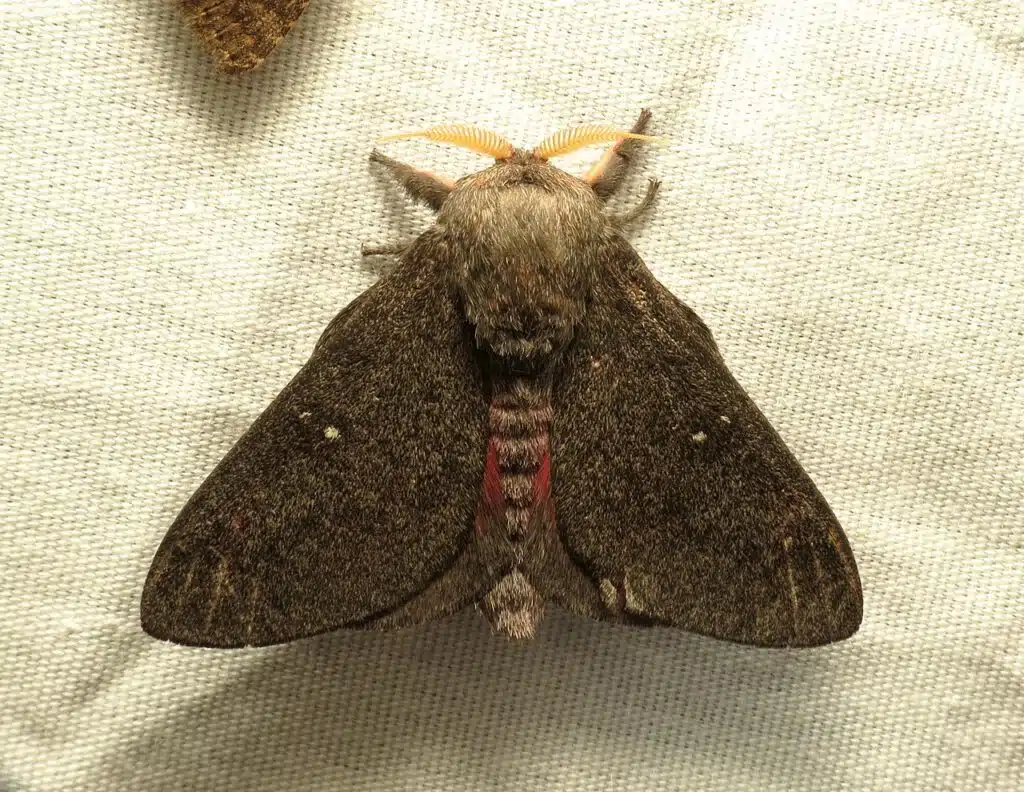
Native to a range between Texas and Eastern California, Hubbard’s Silk Moths (Syssphinx hubbardi) begin life as green caterpillars.
A green body with red or purple lateral bands is specific to the early life stages of this species as a caterpillar.
As an adult, Hubbard’s Silk Moths have dark brown to black forewings and red hindwings.
Only seen when flying, the red hindwings of the species can also be used to keep predators away through warning coloration.
Acacia and honey mesquite are among the most common foods for the species.
Moths of this genus are known for their large size which also makes them some of the largest moths in the Southwestern United States and Mexico.
While males are considerably smaller, female Hubbards’ Silk Moths grow up to a wingspan of 77mm.
The species prefers arid conditions where acacia grows. As a result, it’s widespread around The Sonoran Desert.